Cultural and linguistic diversity among Australians who died with dementia
This page presents data on nearly 27,800 Australians who had dementia recorded on their death certificate between September 2016 and December 2017, and had a linked 2016 Census record in the Multi-Agency Data Integration Project (MADIP). This includes information and statistics on CALD patterns by:
It should be noted that the rate of “not stated” responses to questions in the Census are often relatively high for people with dementia, particularly for people living in residential aged care. When this is the case, the results should be interpreted with caution.
Region of birth
In the MADIP, country of birth information was available for 99% of people who died with dementia.
Of the people who died with dementia:
- 2 in 3 people were born in Australia and 1 in 3 were born overseas.
- 1 in 5 people (20%) were born in a non-English speaking country, most commonly European countries such as Italy, Greece and Germany (Table S13.11).
A smaller proportion of younger people who died with dementia (aged 35–74) were born in non-English speaking countries (15%) compared with people aged 75 and over (21%) (Figure 13.7).
Figure 13.7: People who died with dementia between September 2016 and December 2017: percentage by region of birth for each age group
Figure 13.7 is a bar graph that shows the proportion of people who died with dementia between September 2016 and December 2017 who were born in English-speaking countries or non-English speaking countries. These result are disaggregated by age. Around 80% of people who died with dementia were born in English speaking countries. This proportion was slightly higher for those who died aged 35–74 (85%) compared with those aged 75 and over (79%).
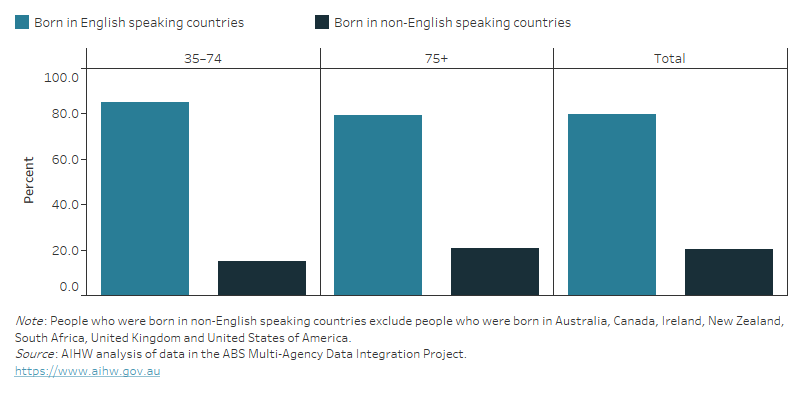
A higher proportion of the overseas-born population who died with dementia were men (43%), when compared to the Australian-born population (38%), while the proportion of women was lower (57% of the overseas-born population, compared to 62% of those born in Australia) (Table S13.12). This difference could be influenced by the prioritization of male migration from some countries after World War II (Wilson et al. 2020).
The median age at death was similar for Australian-born and overseas-born people who died with dementia (88 years and 87 years, respectively). The median age at death for women (89 years) was higher than that for men (86 years) for both overseas- and Australian-born people (Table S13.12).
Place of residence
Of the people who died with dementia, when they completed the 2016 Census:
- Over half (51%) lived in a residential aged care facility.
- This was only slightly lower among people born in non-English speaking countries (48%) than those born in English speaking countries (52%).
- 29% lived in a private dwelling.
- This was higher among people born in non-English speaking countries (36%) than those born in English speaking countries (27%).
- 17% lived in accommodation for the retired or aged (other than a residential aged care facility).
- This was lower among people born in non-English speaking countries (13%) than those born in English speaking countries (18%) (Figure 13.8).
Figure 13.8: People who died with dementia between September 2016 and December 2017: percentage by place of residence and region of birth
Figure 13.8 is a bar graph that shows the proportion of people who died with dementia between September 2016 and December 2017 who lived in each residence type, by whether they were born in an English speaking country. People who died with dementia were primarily living in residential aged care, followed by private housing. 36% of those born in non-English speaking countries who died between September 2016 and December 2017 were living in private housing in August 2016. This compares to27% of people born in English speaking countries.
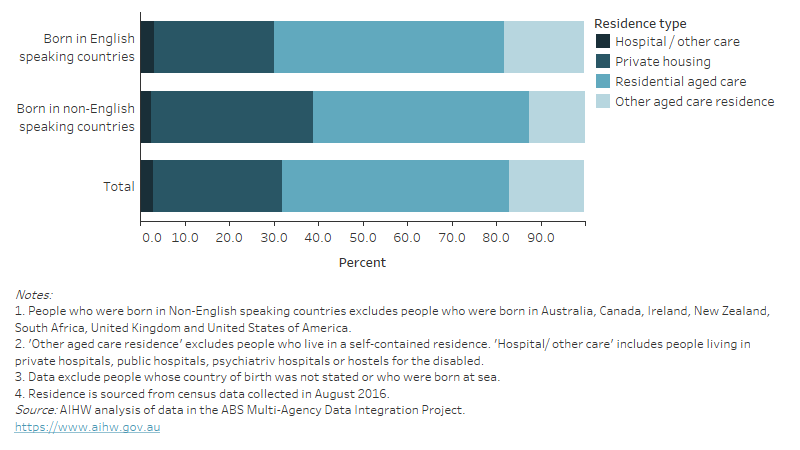
Year of Arrival and Country of Birth
The different waves of migration to Australia (Wilson et al. 2020) are evident in the reported country of birth and year of arrival in Australia of people who died with dementia between September 2016 and December 2017 (Figure 13.9):
- Those born in Southern and Eastern Europe and North–West Europe predominantly immigrated to Australia between the late 1940s and the 1960s. For example, 75% of people born in Southern and Eastern Europe (including Italy and Greece) who died with dementia arrived in Australia between 1946 and 1965.
- People born in Asia, the Middle East and Africa more commonly immigrated to Australia after the mid-1960s. For example, 67% of people born in South East Asia (including Vietnam and the Philippines) who died with dementia arrived between 1976 and 1995.
Consideration of these migration patterns will be important in assessing and planning for the cultural needs of the dementia population as the population overall ages. Similarly, such patterns may be considered in assessing the needs of people with younger onset dementia, which may differ from older people with dementia. Importantly, the cultural diversity of Australia’s older population may continue to change, as younger migrants from Asian countries support the migration of older relatives to Australia (Wilson et al. 2020).
Figure 13.9: People who died with dementia between September 2016 and December 2017: percentage by year of arrival and region of birth
Figure 13.9 is a table that shows the proportion of people who died with dementia between September 2016 and December 2017, by the world region in which they were born and their decade of arrival in Australia. Among those who died with dementia, those born in Southern and Eastern Europe and North-west Europe predominantly immigrated to Australia between the late 1940s and the 1960s. People born in Asia, the Middle East and Africa more commonly immigrated to Australia after the mid-1960s.
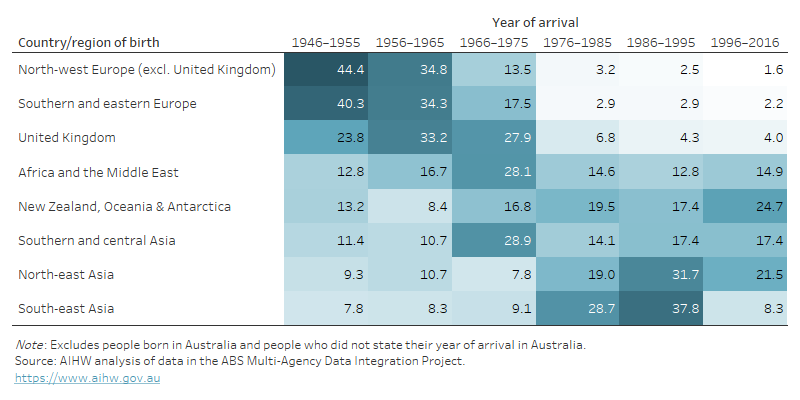
Ancestry, language spoken at home and English proficiency
Ancestry reporting provides additional detail about a person’s cultural affiliations. Respondents were able to report up to two ancestries in the 2016 Census, although 26% of people who died with dementia did not state any ancestry. Where ancestry information was reported, the most commonly reported ancestries of people who died with dementia were British (38%), Australian (30%), Irish, (7.3%), Southern and Eastern European (excluding Italian and Greek) (5.5%), Italian (5.1%) and German (4.0%) (Table S13.15).
In 2016, 83% of Australian-born people who died with dementia reported speaking only English at home and 1% reported speaking a different language. In comparison, 46% of the overseas-born population (includes English and non-English speaking countries) who died with dementia spoke a language other than English at home, and 41% reported speaking only English (Table S13.16).
These proportions differed for people who were born in non-English speaking countries: 16% spoke only English at home, and 73% spoke a language other than English. The most common of these languages were:
- Italian (19%)
- Eastern European languages (15%)
- Northern European languages (10%)
- Greek (10%)
- Chinese languages (5.1%)
- Southern European languages, excluding Italian and Greek (5.1%) (Table S13.17).
Of those born overseas, 31% reported that they did not speak English well, or not at all. Patterns of English proficiency varied depending on the year of arrival of migrants who died with dementia (Table S13.18–20).
- 45% of relatively recent migrants (arrived since 1996), either did not speak English well, or not at all. The most common regions of birth for this group were Southern and Eastern Europe (including Italy and Greece) (29%), North-East Asia (including China) (29%), and North Africa and the Middle East (15%).
- 30% of earlier migrants (arrived before 1996) did not speak English well, or not at all, with Italy (30%), Southern and Eastern Europe (excluding Italy and Greece) (24%) and Greece (16%) the most common regions of birth in this group.
Religious affiliation
Christianity was the most commonly reported religion for Australian-born (69%) and overseas-born (67%) people who died with dementia (Figure 13.10). People born overseas were more likely to report a religion other than Christianity (5.5%), compared to people born in Australia (0.3%). A similar proportion reported they had no religious affiliation (13% of overseas-born and 14% of Australian-born people).
Figure 13.10: People who died with dementia between September 2016 and December 2017: percentage by region of birth and religion
Figure 13.10 is a bar graph that shows the proportion of people who died with dementia between September 2016 and December 2017, by whether they were born overseas and broad religious affiliation (if any). The majority of people who died with dementia had reported in the August 2016 census that they were Christian, for both those born overseas and those born in Australia. People born overseas were more likely to report that they belonged to religions other than Christianity.
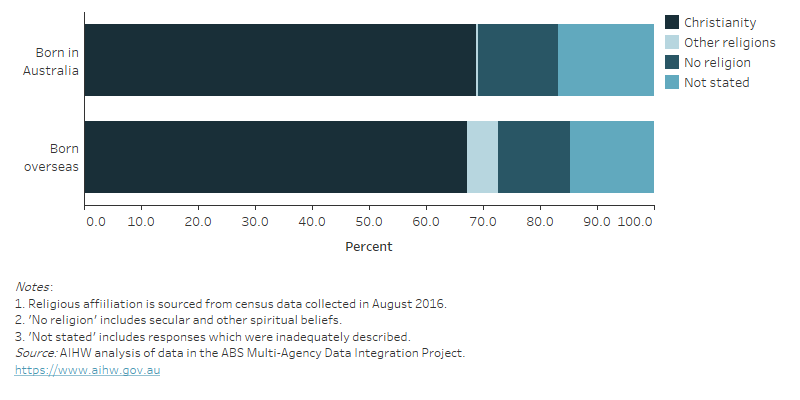
Education
Lower levels of education are a modifiable risk factor for dementia (Livingston et al. 2020), and in Australia, dementia mortality rates are higher in people with lower levels of education (Welsh et al. 2021).
Among people who died with dementia, rates of no educational attainment were:
- higher among older people (aged 75 or over at the 2016 Census) born overseas (5.2%) compared with those born in Australia (0.5%)
- similar among younger people (aged 35–74 at the 2016 Census) in the overseas-born and Australian-born populations (2.5% and 2.4%, respectively) (Figure 13.11).
In the 2016 Census, questions about education were either not answered or inadequately described for 41% of respondents who subsequently died with dementia, compared to 24% of older Australians overall. For people who died with dementia, missing fields were more common for those living in residential aged care and other care facilities (51%) compared to those living in the community (17%). People living in residential aged care and other care facilities may have the census form completed for them by another person, which can lead to higher rates of not stated responses for some questions. Therefore, the following results do not represent all people who died with dementia and should be interpreted with caution.
Figure 13.11: People who died with dementia between September 2016 and December 2017: percentage by educational attainment, age and region of birth
Figure 13.11 is a bar graph that shows the proportion of people who died with dementia between September 2016 and December 2017 who had completed different levels of education, by whether or not they were born overseas and age. Among older people (75+), 5.2% of those born overseas had no educational attainment recorded and this compared with 0.5% of those born in Australia. Rates of no educational attainment were similar among younger people regardless of whether they were born in Australia. Overall, around half of people who died with dementia had completed education up to Year 12 or Certificate III/IV. Note that a high proportion (41%) did not state, or inadequately described, their level of education.
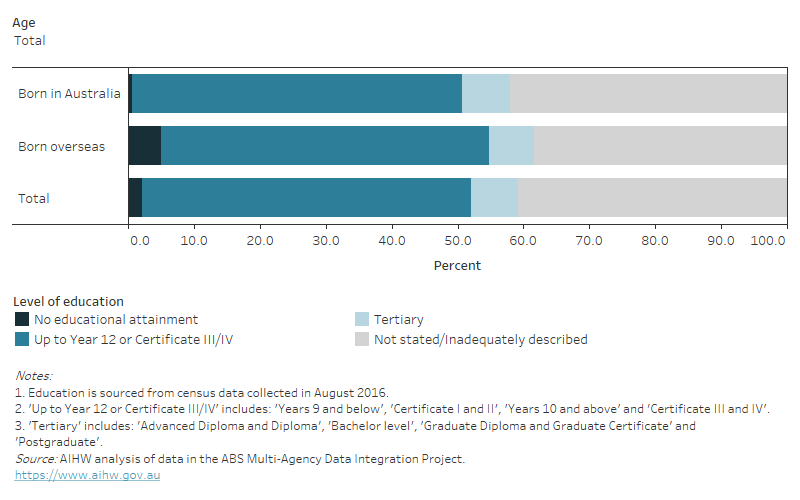
Welsh J, Joshy G, Moran L, Soga K, Law HD, Butler D, Bishop K, Gourley M, Eynstone-Hinkins J, Booth H, Moon L, Biddle N, Blakely A, Banks E and Korda RJ (2021) 'Education-related inequalities in cause-specific mortality: First estimates for Australia using individual-level linked census and mortality data', International Journal of Epidemiology, 50:1981-1994, doi:10.1093/ije/dyab080.
Wilson T, McDonald P, Temple J, Brijnath B and Utomo A (2020) 'Past and projected growth of Australia’s older migrant populations', Genus 76(20), doi:10.1186/s41118-020-00091-6.


